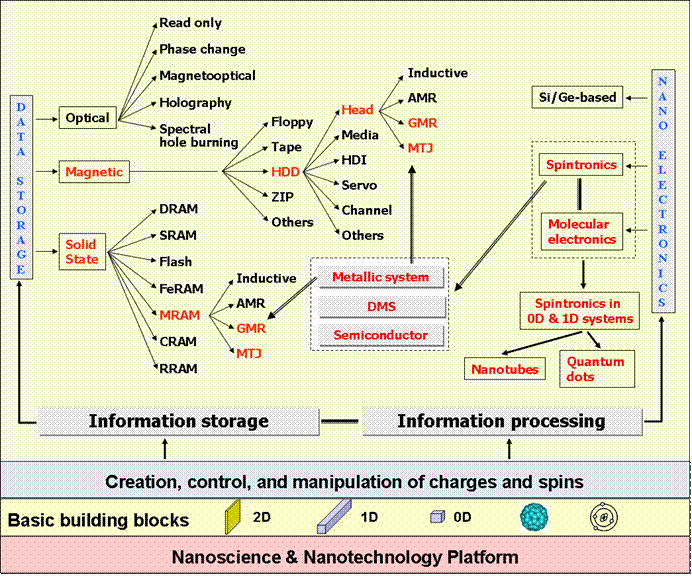Information Storage Materials Laboratory
The Information Storage Materials Laboratory (ISML) is one of the CDE’s joint laboratories with the Data Storage Institute. Established in 2001, ISML has built up its facilities through research grants provided mainly by A*STAR with a funding of about S$9 million. It started first with metal-based spintronic materials and devices for ultra-high density data storage applications, and very recently, with the support of A*STAR again, a project on magnetic semiconductor based spintronics has been initiated. To further build up the state-of-art-facility and extend the scope of the research into the regime where bits meet atoms and charges interact with spins, the laboratory is currently in the process of establishing a major fabrication and characterization tool for research on nanometer scale spintronic materials and devices. The major research topics include:
- Magnetic nanostructures
- Spin-dependent transport
- Modeling of spintronic devices
- Nanometer scale spintronic sensors
- Nano-memory devices
- Single spin detection techniques
- New materials
Presently, there are more than 25 students pursuing a graduate degree at ISML. Researchers and staff at ISML were honored with several distinguished awards including the TR100, NUS Young Researcher Awards for two years consecutively in 2003 and 2004, Singapore Youth Award in 2004 for science and technology and the highest recognition in Singapore for achievers under the age of 35.
During the last few years, we have established extensive collaborations with both local and international research groups and organizations which include Hitachi Global Storage Technologies in San Jose , USA , the Department of Physics, NUS, and the Data Storage Institute. We are also a member of the Information Storage Industry Consortium (INSIC) which is the major international research partnership comprising industry and recognized university groups.
The work at ISML is funded by NUS and A*STAR (total funding received so far > S$15M). We have also received support from INSIC.
Research Highlights:
- Magnetic nanostructures
- Spin-dependent transport (experiment)
- Magnetic logic
- Magnetic recording sensors (CIP, CPP, MTJ, etc.)
- Magnetic random access memory
- Granular structures
- Half-metals
- Zinc-blende half-metallic ferromagnets
- Diluted magnetic semiconductors
- Nanoscale magnetic imaging (High resolution MFM tips)
- Micromagnetic modeling
- Spin-dependent transport (Modeling)
- Biomagnetics
Bits meet atoms and charges interact with spins. These are the possible scenarios for future information processing and storage devices. This trend will become more visible in the next decade or so when Si-based electronics reaches the sub-5 nm regime and at the same time viable techniques become available for generating and manipulating spins in not only metals but also semiconductors. The research activities of this group are focused on nanometer scale spintronics and molecular electronics. The former has already found applications in data storage as ultra sensitive sensors and memory cells. Extensive efforts are also being made to make it applicable to logic devices through the development of semiconductor-based spintronics. From a more fundamental point of view, however, molecules are the best platform for manipulating both charges and spins which may eventually lead to the emerge of totally new concepts and devices. Therefore, we focus on both spin and molecular electronics.
Facilities:
Class 100 clean room
Fabrication tools
- Multi target sputtering system
- Electron beam lithography system (EBL)
- Molecular beam epitaxy system (MBE)
- Thermal and e-beam evaporator
Micro patterning and processing equipment
- Mask aligner (online booking system)
- Spin coater (online booking system)
- Hot plate
- Wire Bonder
- Ozone stripper
- Ion-beam etcher
Characterization tools
- 10K cryostat
- Magnetoresistance measurement kit
- 4-point probe system
- Microscopic optical characterization system
- Surface profiler
- Scanning electron microscope (SEM)
- Scanning probe microscopy (SPM/AFM/MFM) system
- Vibrating sample magnetometer (VSM)
Lab Supervisor:
Contact:
Laboratory Technologist: Mdm Loh Fong Leong
Contact number: +65 66017030
Lab Location:
Information Storage Materials Laboratory
Department of Electrical and Computer Engineering
Block E6, Level 2, Room 05
5 Engineering Drive 1
Singapore 117608


